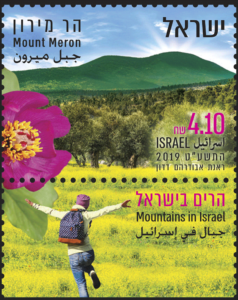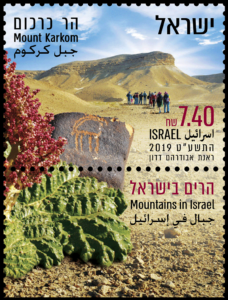Issue Date: March 5, 2019
[press release]
In the Book of Psalms the poet wrote: “I turn my eyes to the mountains”, asking in times of trouble and distress, “from where will my help come?” High mountains that ascend toward the heavens have been perceived throughout history as sacred sites, places where the gods dwell or as worthy places of prayer to God in heaven.
This was not the only reason that people climbed to the mountaintops. The spectacular scenery visible from the summit, the unique plants that could be found there and the animals that lived solely at great heights all lured the people residing at the foot of the mountain to gather their strength and ascend to the summit. In order to preserve this special environment, some of the most noteworthy mountains in Eretz Israel, such as Mount Meron and Mount Karkom, have been designated as Nature Reserves.
Mount Meron
The Mount Meron range towers above the Upper Galilee region. Soaring to the height of 1204 meters above sea level, Mount Meron is the tallest mountain in Ere tz Israel west of the Jordan River and is one of the rainiest areas in Israel, and even has occasional snowfall during the winter months. These conditions allow plants such as the Wild Peony featured on the stamp, which are typical of the mountains in Turkey and Lebanon, to grow on Mount Meron, the southernmost point of their dispersion. Hiking trails are marked around the summit and along the slopes, leading visitors among the mountain’s many delightful natural and archeological treasures. Important prayer sites lie at the foot of the Mount Meron range, the most significant of which are the grave of Rabbi Shimon bar Yochai which is sacred to the Jews and the grave of Nabi Sablan, a sacred prophet of the Druze people.
tz Israel west of the Jordan River and is one of the rainiest areas in Israel, and even has occasional snowfall during the winter months. These conditions allow plants such as the Wild Peony featured on the stamp, which are typical of the mountains in Turkey and Lebanon, to grow on Mount Meron, the southernmost point of their dispersion. Hiking trails are marked around the summit and along the slopes, leading visitors among the mountain’s many delightful natural and archeological treasures. Important prayer sites lie at the foot of the Mount Meron range, the most significant of which are the grave of Rabbi Shimon bar Yochai which is sacred to the Jews and the grave of Nabi Sablan, a sacred prophet of the Druze people.
Mount Karkom
In the southwestern Negev Desert, along the banks of the Paran River, the flat summit of Mount Karkom is located 847 meters above sea level. The broad flat upper portion of the mountain sits atop steep slopes that soar 200 meters above the surrounding area. The view from the top of Mount Karkom is breathtaking, allowing visitors to see large parts of the arid southern Negev Desert as well as the Sinai Desert. More than 40,000 rock drawings have been discovered on Mount Karkom and in the immediate area. These were carved by humans and include figures such as the Long Horned Deer that appears on the stamp. Many of the rock drawings show humans with their arms outstretched toward the heavens as if in prayer. The aridness of the area surrounding the mountain (which does not allow permanent inhabitance) along with the existence of the many rock drawings have led researchers to conclude that Mount Karkom served as a sacred place of worship and prayer, visited by caravans of merchants passing through the area and groups of believers who travelled there from distant lands. Prof. Emmanuel Anati, who devoted many years to researching the site, identified Mount Karkom as the Mount Sinai noted in the Bible, however this opinion is not accepted by most researchers in the field.
Negev Desert as well as the Sinai Desert. More than 40,000 rock drawings have been discovered on Mount Karkom and in the immediate area. These were carved by humans and include figures such as the Long Horned Deer that appears on the stamp. Many of the rock drawings show humans with their arms outstretched toward the heavens as if in prayer. The aridness of the area surrounding the mountain (which does not allow permanent inhabitance) along with the existence of the many rock drawings have led researchers to conclude that Mount Karkom served as a sacred place of worship and prayer, visited by caravans of merchants passing through the area and groups of believers who travelled there from distant lands. Prof. Emmanuel Anati, who devoted many years to researching the site, identified Mount Karkom as the Mount Sinai noted in the Bible, however this opinion is not accepted by most researchers in the field.
Description of the Stamps:
Mount Meron Stamp
Photo – Mount Meron Range – Eyal Bartov
Photo – Wild Peony – Lior Almagor
Photo – Hiker – Shutterstock
Mount Karkom Stamp
Photos – Mount Karkom and Rock Drawing – Moshe Rimer
Photos – Hikers and Desert Rhubarb – Eyal Bartov



